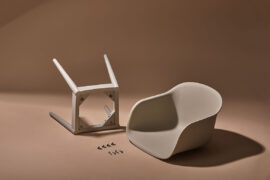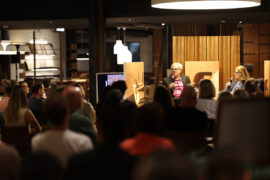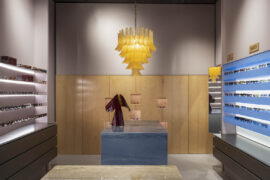In the multi-billion dollar business of replica furniture production, we ask the tough questions about what bootlegging is doing to our design industry.

July 2nd, 2018
As a child, I was fascinated by dressing room mirrors. Two mirrors facing one another provided amusement that seemed at first as infinite as the reflected versions of myself, stretching out in long, interminable lines in each direction. After a few minutes, though, the novelty always slipped into horror, the endless replicas of me suddenly plunging into the realm of the grotesque.
I am reminded of this childhood fascination every time I see another “Eames chair” with a $50 price tag, or the IKEA FROSTA, which looks mysteriously like Alvar Aalto’s 60 Stool. In almost every case, the replicas are cheaper, lower quality facsimiles of iconic designs from the 1920s to 1960s – emblems of perennially in style mid-century chic.
At first, the concept of replica furniture has its novel charm – who can resist a bargain? – but this is underpinned by an undeniable sense of strangeness. “If there was a big store selling $20 million worth of fake Louis Vuitton, that wouldn’t be celebrated in the press,” mused Priyanka Rao, Chief Executive of Woodmark Furniture, to the Australian Financial Review, “…but for some reason with furniture it’s ok.”
But is it really?
In Australia, the “some reason” is the complex legal landscape of intellectual property (IP) law. IP protections only extend to designs for a maximum of ten years: designers register their design with the Australian Department of Communications and the Arts for a five-year period, after which they may elect to renew the registration for another five years.
Once this second period elapses, the design is officially out of copyright and can be reproduced without legal consequences – as long as they are clearly identified as replicas. The brevity of this protection relegates Australian design objects to a curious second-tier of protection that sits beneath other forms of artistic output including literature, music, and visual arts, which are protected for 70 years after the author’s death.
This quirk of the legal system combines with another key factor to create a strong local market for replica furniture: licensed editions of designer furniture are undeniably costly. A licensed Eames® lounge chair will set you back over $9000, while a replica comes at a comparatively meagre $599. Contemporary consumer culture dictates that to pay the higher price is absurd, particularly given that to the undiscerning eye, the replica is indistinguishable from the original. Or at the very least, visually indistinguishable.
Yet while replicas may be similar to the originals at first glance, the reality is that they aren’t similar at all. Licensed designer furniture is expensive because licensing – legally acquiring the rights to reproduce a design that is still under copyright – is expensive. This is coupled with the fact that buying an original Eames or Saarinen chair means paying not just for the chair, but for everything that preceded it: the craftsmanship, the high-quality materials, the time, effort, and skill that went into refining the design.
You pay for none of this when you purchase a replica, in which case you are essentially buying the image of the design, often blurred by cheap materials, poor construction, and a short product lifespan.
This of course begs the question of why? On paper, the goal of replica furniture is admirable: to make great design accessible to more people than the privileged few. Yet IKEA (and a handful of smaller retailers) have repeatedly shown that furniture can be both original (FROSTA stool aside) and affordable, and it is unlikely that suppliers of replica furniture are working magnanimously toward providing equal access to luxury goods rather than simply profiting off the back of someone else’s work.
In many ways, those willing to spend $599 on an unlicensed copy of a luxury item would be better off spending the money on a cheaper item of decent quality and unburdened by the dubious ethics of unlicensed replicas.
Certainly, the co-existence of the market for a $9000 lounge chair and its $599 knock-off indicates that one does not extinguish the other. But to consider replica furniture on this ground – that it does not preclude the existence of licensed originals – is beside the point, and ignores the repercussions of replica culture.
For companies like Herman Miller, who in 2011 sued Australian retailer Matt Blatt to prevent them from attaching the Eames name to its replicas and ended up settling for an undisclosed sum out of court, replicas are not causing direct economic harm. Rather, they cheapen the image of their prestigious brands and dilute their legacy by making it ubiquitous.
While unauthorised replicas may not touch the economic bottom line of global giants like Herman Miller, for fledgeling designers they can spell the difference between a viable business and a struggling practice. Australia’s lax IP protections are increasingly threatening already narrow profit margins and smothering the growth potential of brands still establishing themselves within industry. Brazen retailers take advantage of loose legal protections in Australia and the prohibitive cost of litigation, in addition to the onerous task of proving ownership of copyright at all.
In 2015, the Australian Financial Review reported that Australian design wunderkind Ross Gardam was the victim of IP theft when copies of his award-winning Oak Pendant luminaire started retailing at a much lower price on a Melbourne-based e-tailer. The e-tailer in question deleted the sales listing of the luminaire following publication of the article, but the case illustrates one of the major effects of replica culture.
Elsewhere across Australia’s design landscape, one particularly infamous example of replica’s destructive mentality looms large. As one of the country’s most iconic design duos, Grant and Mary Featherston, have proven to be a wellspring for the replica market – attracting generation after generation of IP theft and bootlegging. In particular, their R160 Contour Chair (developed initially in the early 1950s) continues to prove a lucrative racket for the world’s replica producers.
After the watershed private sale in recent years (following hot on the heels of a 1988 retrospective and ongoing representation of the Featherston archive in Australian design exhibits), commercial interest in the Featherston design universe continues to rise.
As I write this, three local retailers in Surry Hills (NSW) stock replicas of this exact piece. Beyond that, Australia’s largest retailer of domestic furniture has stocked replicas of this piece for several years. It begs the question: what’s the true cost of lining one’s pockets? With such lax IP protection in this country – and with obviously low respect to the Featherston family in this ongoing litany of replication – have we denatured our own design legacy?
To unquestioningly accept the replica is to implicitly devalue innovative, unique design. It entices retailers hoping to earn a tidy profit by simply emulating the work of others, and encourages them to do so with impunity. What’s more, replica culture reduces the incentive for designers to invest time, money, and creative effort into developing new designs. Why should a designer strive toward anything unique or revolutionary, when the market would rather pay for budget replicas of hashed-out designs?
As Rao points out, there are parallels between the furniture and fashion design industries that cannot be denied. While the knock-off – excuse me, replica – market for designer clothing and accessories certainly exists, it is not welcomed in the same way that the global design industry has embraced replicas.
This coincides with the ongoing shift of the fashion industry away from ‘fast fashion’ and toward a more conscious mode of consumption that prioritises ethical production chains and one-of-a-kind pieces.
Only time will tell if this shift will be fully translated into the furniture industry: for now, the wheels are being set in place by the Authentic Design Alliance, a body established in 2010 to support original, authentic design and protect the intellectual property rights of designers and licensed manufacturers.
Hopefully, everyone else will be inspired to follow suit.
This article is proudly presented by IndesignLive in collaboration with grazia&co.
INDESIGN is on instagram
Follow @indesignlive
A searchable and comprehensive guide for specifying leading products and their suppliers
Keep up to date with the latest and greatest from our industry BFF's!

CDK Stone’s Natasha Stengos takes us through its Alexandria Selection Centre, where stone choice becomes a sensory experience – from curated spaces, crafted details and a colour-organised selection floor.

For those who appreciate form as much as function, Gaggenau’s latest induction innovation delivers sculpted precision and effortless flexibility, disappearing seamlessly into the surface when not in use.

London-based design duo Raw Edges have joined forces with Established & Sons and Tongue & Groove to introduce Wall to Wall – a hand-stained, “living collection” that transforms parquet flooring into a canvas of colour, pattern, and possibility.

Merging two hotel identities in one landmark development, Hotel Indigo and Holiday Inn Little Collins capture the spirit of Melbourne through Buchan’s narrative-driven design – elevated by GROHE’s signature craftsmanship.

MillerKnoll releases the 2025 Better World Report showcasing how design can drive meaningful change through measurable progress across social, environmental and governance initiatives

He’s the Director of Eames Office and an all-round creative polymath – and Eames Demetrios has just been in our region with Living Edge.
The internet never sleeps! Here's the stuff you might have missed

A calm, gallery-like boutique by Brahman Perera for One Point Seven Four brings contemporary luxury and craft to Strand Arcade.

Australia’s first planted light rail corridor sets new benchmark for transport-led urban transformation.